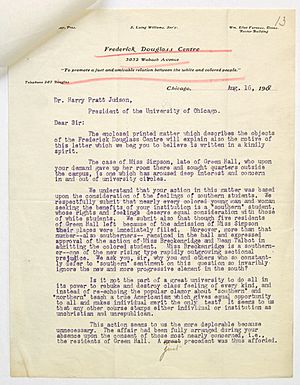Georgiana Simpson facts for kids
Quick facts for kids
Dr.
Georgiana Rose Simpson
|
|
|---|---|

Simpson in 1921, wearing academic dress for her graduation from the University of Chicago
|
|
| Born | 1865 |
| Died | 1944 (aged 78–79) |
| Nationality | American |
| Alma mater | University of Chicago |
| Occupation | Professor |
| Scientific career | |
| Institutions | Howard University |
| Thesis | 'Herder's Conception of "Das Volk"' (1921) |
Georgiana Rose Simpson (1865–1944) was an amazing American scholar. She was a philologist, which means she studied languages and old texts. Dr. Simpson made history as the first African-American woman to earn a PhD degree in the United States. She received her PhD in German from the University of Chicago in 1921.
Early Life and Education
Georgiana Simpson was born in Washington, D.C., on March 31, 1865. She was the oldest daughter of David and Catherine Simpson. She went to public schools in Washington, D.C.
After finishing school, she trained to become a teacher at the Miner Normal School. In 1885, she started teaching in elementary schools. She often taught in communities where many German immigrants lived. One of her former teachers, Dr. Lucy E. Moten, encouraged her to keep learning and study German in college.
Simpson began studying at the University of Chicago in 1907. She earned her bachelor's degree in German in 1911. To avoid the unfair treatment (racism) she faced on campus, she mostly completed her studies through summer classes and courses taken by mail.
She earned her master's degree in 1920. Her master's paper, called The Phonology of Merigarto, looked at an old German poem. While studying for her advanced degrees, Simpson also taught at Dunbar High School in Washington, D.C. At 55 years old, she finished her main research paper, Herder's Conception of "Das Volk". She received her PhD in German on June 14, 1921.
Facing Challenges During Segregation
Dr. Simpson's achievements are often talked about in the context of the civil rights movement. This was a time when laws and customs in the U.S. led to segregation, meaning people of different races were kept separate.
When Simpson first started at the University of Chicago, she faced unfair treatment. She was invited to live in the women's dormitory. However, some white students protested her living there. The head of the dormitory, Sophonisba Breckinridge, first asked Simpson to leave. But Simpson bravely refused.
Breckinridge then changed her mind and said Simpson could stay. However, the university president, Harry Pratt Judson, overruled this decision. He asked Simpson to leave, and she did. Because of this, Simpson chose to take most of her classes during the summer. This helped her avoid more conflicts with the mostly white students, many of whom were from the southern U.S.
A group called the Frederick Douglass Centre even sent a letter to President Judson. The letter criticized the university's decision to make Simpson leave the dormitory. It said her case caused "deep interest and concern."
Contributions and Legacy
Georgiana Simpson was the first black woman in the United States to earn a doctoral degree. Around the same time, other black women scholars like Sadie Tanner Mossell, Eva B. Dykes, and Anna Julia Cooper also earned their PhDs. Even with these high achievements, their lives were not immediately easier due to discrimination.
For Dr. Simpson, this meant returning to teach at Dunbar High School. At that time, most universities would not hire black women for teaching positions outside of home economics courses.
In 1936, Simpson wrote a letter to W.E.B. Du Bois, a famous civil rights leader. She asked about contributing an article to an encyclopedia project. She wanted to write about "Negro dialect" or the "philosophy of Negro folk literature." Her last major published work was a translation of a French book. This book was about the life of Toussaint L'Ouverture, a leader of the Haitian Revolution.
In 2017, a project called the Monumental Women Project honored Dr. Simpson. They created a sculpture of her. This sculpture was placed in the Reynolds Club at the University of Chicago. It stands directly across from a sculpture honoring President Judson, the same president who asked her to leave the dormitory many years before. This placement helps remember her strength and achievements.


